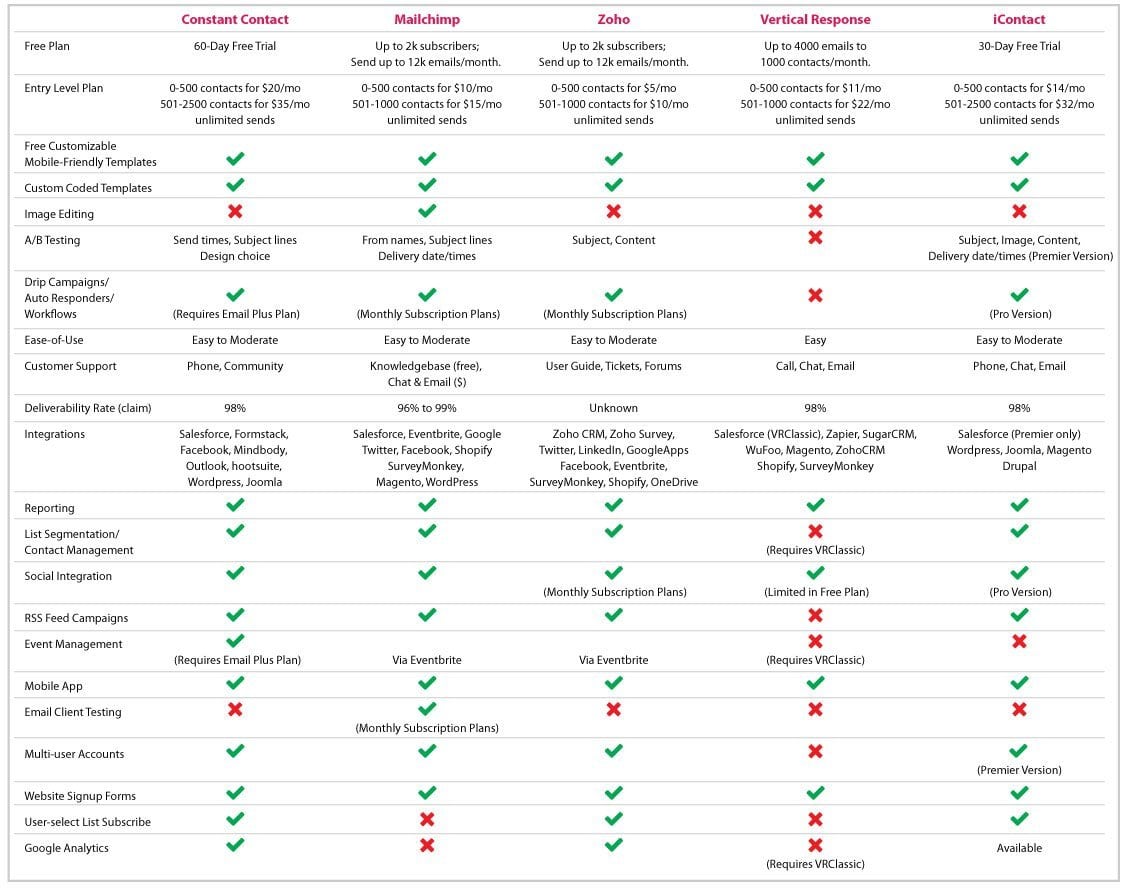Are you looking to enhance your email marketing strategy with the right tools? In the competitive world of digital marketing, choosing the perfect email marketing tool is crucial for business success. From automation capabilities to analytics and reporting features, the options can seem overwhelming. This ultimate guide to choosing the right email marketing tool will help you navigate through the vast array of choices available, comparing top tools and key features to consider for your unique business needs and budget. Whether you are a small business owner or a marketing professional, understanding the Email marketing tools comparison is essential for maximizing your email marketing efforts.

Choosing the Right Email Marketing Tool
Aligning with Business Needs and Goals
When selecting an email marketing tool, start by analyzing your business goals. Consider factors like the size of your subscriber list, desired level of automation, and the complexity of your email campaigns. Understanding your specific needs will guide you towards tools that best suit your objectives, ensuring efficient Email Marketing Tool Comparison.
Budget and Resource Evaluation
Evaluate your budget and available resources realistically. Look for tools that offer pricing plans fitting your financial capacity. Understand the scalability options provided by each tool to ensure a sustainable investment as your business grows. Balancing features with costs is essential when comparing Email Marketing Tool options.
Research and Comparison
Thorough research is key to finding the right Email Marketing Tool. Compare features such as automation workflows, segmentation capabilities, A/B testing, and reporting analytics. Consider user-friendly interfaces and customer support quality. A well-informed comparison will lead you to the most suitable tool for your email marketing efforts.
User Reviews and Testimonials
Delve into user reviews and testimonials to gain insights into the practical experiences of other email marketers. Look for feedback on ease of use, deliverability rates, customer support responsiveness, and overall satisfaction. Real user experiences provide valuable perspectives that can influence your Email Marketing Tool Comparison decision-making process.

Essential Features to Consider
Email Automation and Segmentation
When selecting an email marketing tool, prioritizing robust automation for personalized campaigns is key. Look for platforms that offer advanced segmentation capabilities to target specific audience segments efficiently. Automation streamlines workflows, increases engagement, and drives conversions, enhancing overall email marketing performance.
Analytics and Reporting
Comprehensive analytics are vital for tracking campaign performance. Choose a tool with detailed reporting metrics like open rates, click-through rates, and conversion data. Real-time analytics provide actionable insights to optimize future campaigns, ensuring continuous improvement in email marketing strategies.
Integrations with Other Software
A versatile email marketing tool should seamlessly integrate with other software systems you use. Whether it’s CRM, e-commerce, or social media platforms, integration capabilities enhance data synchronization and campaign consistency. Maximize efficiency by selecting a tool that easily connects with your existing tech stack.
Ease of Use and Customer Support
User-friendly interfaces and reliable customer support are essential for smooth operations. Opt for an intuitive platform with customizable templates and drag-and-drop editors for effortless campaign creation. Additionally, prioritize providers offering responsive customer support to address queries promptly and efficiently.

Top 5 Email Marketing Tools
Mailchimp: Best overall for small businesses
Mailchimp stands out for its user-friendly interface, making it ideal for beginners. It offers a range of templates, automation options, and detailed analytics. With its affordability and scalability, Mailchimp is a top choice for small businesses seeking a comprehensive email marketing tool.
HubSpot: Best for all-in-one marketing automation
HubSpot is renowned for its robust CRM capabilities integrated with email marketing features. This tool streamlines marketing efforts by offering a centralized platform for email campaigns, lead management, and customer relationship management, making it a great option for businesses looking for all-in-one marketing solutions.
Constant Contact: Best for ease of use
Constant Contact is acclaimed for its simplicity and ease of use. It provides customizable templates, social media integration, and reliable customer support, making it perfect for users who prioritize user-friendly interfaces and excellent customer service in their email marketing tool.
ActiveCampaign: Best for advanced automation
ActiveCampaign excels in advanced automation features, including conditional logic and machine learning capabilities. It empowers businesses to create highly personalized and targeted email campaigns based on user behavior, making it a preferred choice for those seeking sophisticated automation functionalities.
ConvertKit: Best for creators and bloggers
ConvertKit is tailored for content creators and bloggers, offering features like subscriber tagging, automation, and segmenting based on user preferences. It enables creators to nurture their audience effectively through personalized content delivery, making it an excellent choice for individuals focused on content-driven marketing strategies.

Unveiling the Pricing and Plans of Email Marketing Tools
Compare the Pricing of Different Tools
When diving into the realm of email marketing tool comparison, it’s essential to evaluate the pricing structures of various tools. Some tools offer tiered pricing based on the number of subscribers or emails sent, while others may have a flat fee. Understanding the pricing models and the value they offer can help you make an informed decision tailored to your budget.
Consider the Features Included in Each Plan
While budget is a crucial factor, it’s equally important to assess the features included in each pricing plan. Look for tools that offer a comprehensive set of features like automation workflows, A/B testing, customizable templates, and advanced analytics. Ensure the plan aligns with your specific marketing goals and the functionalities you require for successful campaigns.
Choose a Plan That Fits Your Budget and Needs
Finding the right balance between cost and features is key when selecting an email marketing tool. Opt for a plan that not only fits your budget but also caters to your business needs. Whether you’re a small business looking for scalability or a larger enterprise requiring extensive integrations, picking a plan that aligns with your current and future objectives is essential for maximizing the tool’s potential.
In the dynamic landscape of email marketing, understanding the pricing and plans of different tools is vital in making an informed decision. By comparing pricing structures, scrutinizing included features, and selecting a plan that suits your budget and requirements, you pave the way for effective email campaigns tailored to your business goals. Dive deep into these aspects to unlock the full potential of your email marketing endeavors.

Tips for Effective Email Marketing
Building a Targeted Email List
Creating a targeted email list is essential for successful email marketing campaigns. Segment your audience based on demographics, behaviors, and preferences to send relevant content. Offer incentives like exclusive deals or content upgrades to encourage subscription. Regularly clean your list to maintain engagement and deliverability rates, ensuring your emails reach the right audience.
Crafting Compelling Subject Lines
Subject lines are the first thing recipients see; make them irresistible. Use action words, create a sense of urgency, or ask questions to spark curiosity. Personalize subject lines with the recipient’s name for a higher open rate. A/B test different variations to see what works best for your audience and improve over time.
Personalizing Your Emails
Personalization enhances the subscriber experience. Address recipients by their names, tailor content based on their past interactions or preferences, and recommend products/services they might like. Use dynamic content to show different offers to different segments. Personalized emails build trust and loyalty, increasing conversion rates.
Using Clear and Concise Language
In the fast-paced world of email, clarity is key. Keep your message to the point and easy to understand. Use engaging language that resonates with your audience. Avoid jargon or complex sentences. Incorporate visuals strategically to break up text and convey information more effectively. Efficient communication leads to better engagement and click-through rates.
Tracking Results and Making Adjustments
Monitoring your email marketing metrics is crucial for optimization. Track open rates, click-through rates, conversion rates, and unsubscribe rates to gauge performance. Analyze data to understand what works and what doesn’t. Test different elements like sending times, content types, and CTAs. Make data-driven decisions to continually improve your email campaigns.

Maximizing Business Potential with Email Marketing Tool Advantages
Automate Campaigns for Efficiency
Utilizing an email marketing tool allows for automated campaigns, saving time and ensuring consistent communication with your audience. Streamline repetitive tasks, schedule emails in advance, and personalize content effortlessly, enhancing engagement and conversion rates. By automating processes, you can focus on strategy and creativity while maintaining a personalized touch in your outreach efforts.
Targeted Audience Segmentation
Segmenting your audience based on demographics, behavior, or interactions is made seamless with email marketing tools. Deliver tailored messages to specific groups, increasing relevance and engagement. Personalizing content to resonate with different segments boosts open rates and drives conversions. Leverage segmentation capabilities to nurture leads effectively and deliver content that addresses individual preferences and needs.
Enhance ROI through Tracking
Tracking and analyzing email campaign performance metrics are fundamental to improving ROI. Email marketing tools offer in-depth insights into open rates, click-through rates, conversions, and more. By understanding what works and what doesn’t, you can refine your strategies for better results. Data-driven decisions based on analytics empower you to optimize campaigns, foster customer loyalty, and drive revenue growth effectively.
Expand Customer Relationships with List Growth
Building a robust email list is key to nurturing leads and fostering customer relationships. Email marketing tools provide list management capabilities, enabling you to grow your subscriber base organically. Engage with prospects, leads, and existing customers through targeted content, promotions, and updates. By consistently delivering value to your audience, you can establish trust, loyalty, and long-term customer relationships, driving business growth and success.

Common Challenges and Solutions in Email Marketing Tool Comparison
Facing low open rates can be frustrating for email marketers. To combat this, focus on crafting compelling subject lines that pique the recipient’s interest. Personalizing emails based on subscriber data can also improve open rates significantly, making your messages more relevant and appealing to your audience.
Dealing with high bounce rates is a common challenge in email marketing. To address this issue, regularly clean your email list by removing inactive or invalid contacts. By verifying email addresses before adding them to your list, you can ensure that your messages reach active recipients, reducing bounce rates and increasing deliverability.
Navigating spam filters is crucial for successful email campaigns. Opt for a reputable email service provider that prioritizes deliverability. Adhere to best practices such as avoiding spam trigger words, maintaining a proper sending frequency, and providing clear opt-out options to stay out of spam folders and reach your subscribers’ inboxes effectively.
Overcoming the lack of engagement from your audience requires creating captivating content. Tailor your emails to provide value and meet the needs of your subscribers. Utilize compelling visuals, personalized recommendations, and clear calls-to-action to encourage interaction and drive engagement. By understanding your audience and their preferences, you can tailor your content to resonate with them effectively.

